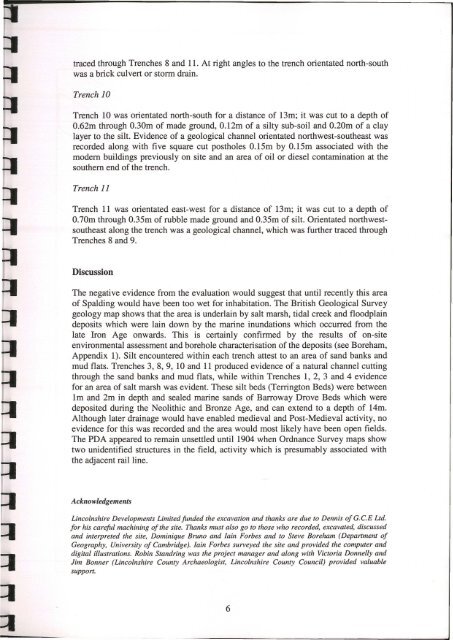The Old Bakery, Ayscough Avenue, Spalding, Lincolnshire
The Old Bakery, Ayscough Avenue, Spalding, Lincolnshire
The Old Bakery, Ayscough Avenue, Spalding, Lincolnshire
Create successful ePaper yourself
Turn your PDF publications into a flip-book with our unique Google optimized e-Paper software.
traced through Trenches 8 and 11. At right angles to the trench orientated north-south<br />
was a brick culvert or storm drain.<br />
Trench 10<br />
Trench 10 was orientated north-south for a distance of 13m; it was cut to a depth of<br />
0.62m through 0.30m of made ground, 0.12m of a silty sub-soil and 0.20m of a clay<br />
layer to the silt. Evidence of a geological channel orientated northwest-southeast was<br />
recorded along with five square cut postholes 0.15m by 0.15m associated with the<br />
modern buildings previously on site and an area of oil or diesel contamination at the<br />
southern end of the trench.<br />
Trench 11<br />
Trench 11 was orientated east-west for a distance of 13m; it was cut to a depth of<br />
0.70m through 0.35m of rubble made ground and 0.35m of silt. Orientated northwestsoutheast<br />
along the trench was a geological channel, which was further traced through<br />
Trenches 8 and 9.<br />
Discussion<br />
<strong>The</strong> negative evidence from the evaluation would suggest that until recently this area<br />
of <strong>Spalding</strong> would have been too wet for inhabitation. <strong>The</strong> British Geological Survey<br />
geology map shows that the area is underlain by salt marsh, tidal creek and floodplain<br />
deposits which were lain down by the marine inundations which occurred from the<br />
late Iron Age onwards. This is certainly confirmed by the results of on-site<br />
environmental assessment and borehole characterisation of the deposits (see Boreham,<br />
Appendix 1). Silt encountered within each trench attest to an area of sand banks and<br />
mud flats. Trenches 3, 8, 9, 10 and 11 produced evidence of a natural channel cutting<br />
through the sand banks and mud flats, while within Trenches 1, 2, 3 and 4 evidence<br />
for an area of salt marsh was evident. <strong>The</strong>se silt beds (Terrington Beds) were between<br />
lm and 2m in depth and sealed marine sands of Barroway Drove Beds which were<br />
deposited during the Neolithic and Bronze Age, and can extend to a depth of 14m.<br />
Although later drainage would have enabled medieval and Post-Medieval activity, no<br />
evidence for this was recorded and the area would most likely have been open fields.<br />
<strong>The</strong> PDA appeared to remain unsettled until 1904 when Ordnance Survey maps show<br />
two unidentified structures in the field, activity which is presumably associated with<br />
the adjacent rail line.<br />
Acknowledgements<br />
<strong>Lincolnshire</strong> Developments Limited funded the excavation and thanks are due to Dennis of G.C.E Ltd.<br />
for his careful machining of the site. Thanks must also go to those who recorded, excavated, discussed<br />
and interpreted the site, Dominique Bruno and lain Forbes and to Steve Boreham (Department of<br />
Geography, University of Cambridge). Iain Forbes surveyed the site and provided the computer and<br />
digital illustrations. Robin Standring was the project manager and along with Victoria Donnelly and<br />
Jim Bonner (<strong>Lincolnshire</strong> County Archaeologist, <strong>Lincolnshire</strong> County Council) provided valuable<br />
support.<br />
6

















